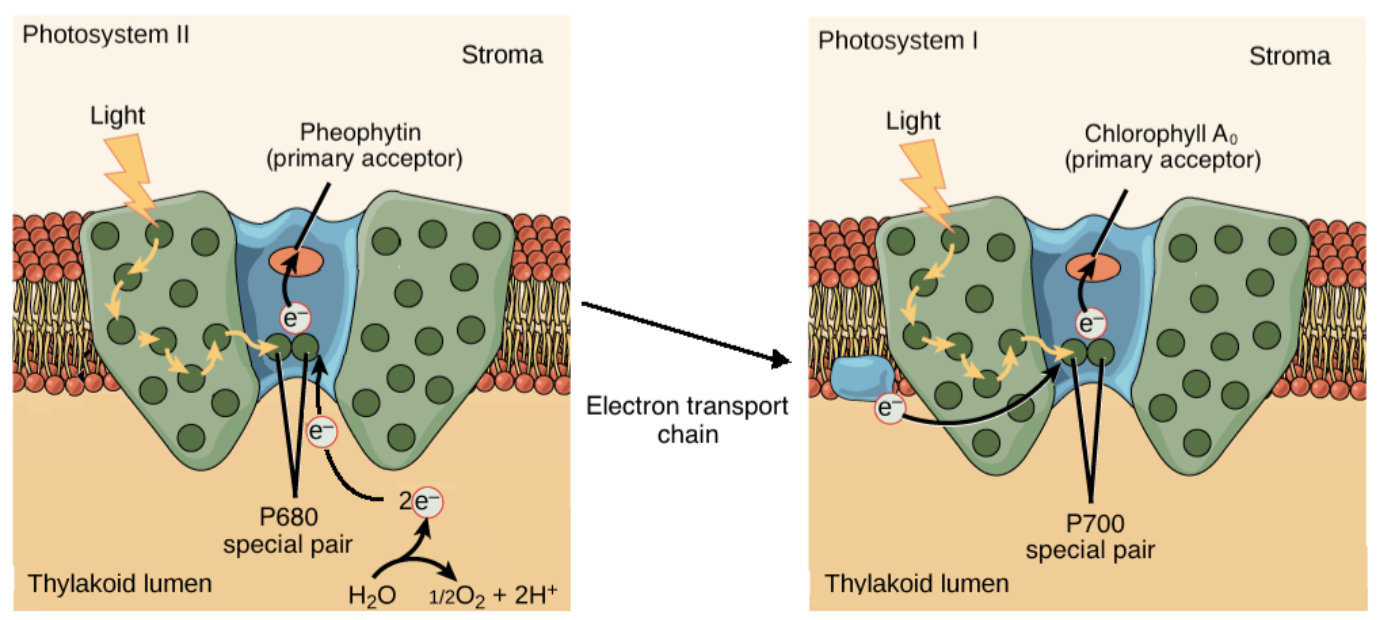photosystems (light dependent reactions)
0.0(0)
0.0(0)
New
Card Sorting
1/9
Earn XP
Description and Tags
Study Analytics
Name | Mastery | Learn | Test | Matching | Spaced |
|---|
No study sessions yet.
10 Terms
1
New cards
General Steps of Light Reactions
1. Light absorption in PSII
2. ATP synthesis
3. Light absorption in PSI
4. NADPH formation
2. ATP synthesis
3. Light absorption in PSI
4. NADPH formation
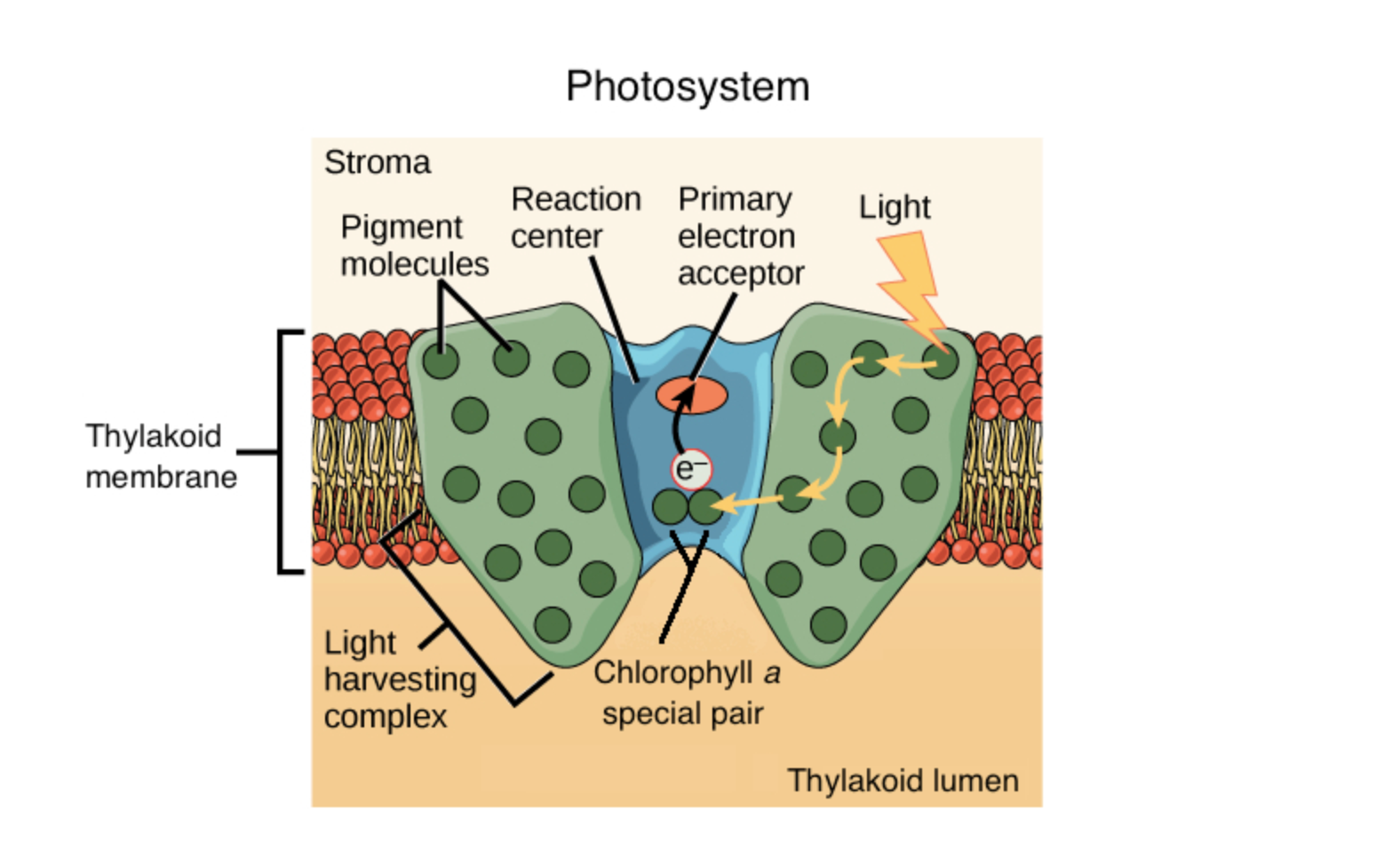
2
New cards
Light absorption in PSII
When light is absorbed by one of the many pigments in photosystem II, energy is passed inward from pigment to pigment until it reaches the reaction center. There, energy is transferred to P680, boosting an electron to a high energy level. The high-energy electron is passed to an acceptor molecule and replaced with an electron from water. This splitting of water releases the O2 we breathe.
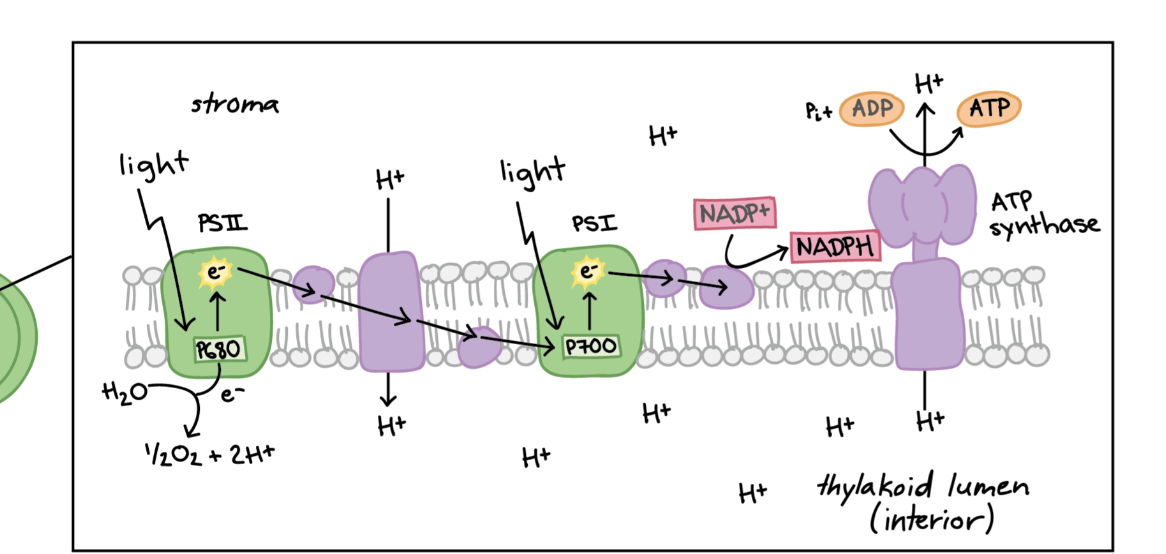
3
New cards
ATP synthesis
- The high-energy electron travels down an electron transport chain, losing energy as it goes. Some of the released energy drives the pumping of H+ ions from the stroma into the thylakoid interior, building a gradient.
(H+ ions from the splitting of water also add to the gradient.)
- H+ ions flow down their gradient and into the stroma, they pass through ATP synthase, driving ATP production in a process known as chemiosmosis.
(H+ ions from the splitting of water also add to the gradient.)
- H+ ions flow down their gradient and into the stroma, they pass through ATP synthase, driving ATP production in a process known as chemiosmosis.
4
New cards
Light absorption in PSI
- The electron arrives at photosystem I and joins the P700 special pair of chlorophylls in the reaction center
- When light energy is absorbed by pigments and passed inward to the reaction center, the electron in P700 is boosted to a very high energy level and transferred to an acceptor molecule
- The special pair's missing electron is replaced by a new electron from PSII (arriving via the electron transport chain).
- When light energy is absorbed by pigments and passed inward to the reaction center, the electron in P700 is boosted to a very high energy level and transferred to an acceptor molecule
- The special pair's missing electron is replaced by a new electron from PSII (arriving via the electron transport chain).
5
New cards
NADPH formation
- The high-energy electron travels down a short second leg of the electron transport chain
- At the end of the chain, the electron is passed to NADP+
(along with a second electron from the same pathway) to make NADPH.
- At the end of the chain, the electron is passed to NADP+
(along with a second electron from the same pathway) to make NADPH.
6
New cards
cyclic photophosphorylation
- electrons follow a different, circular path and only ATP (no NADPH) is produced} light-driven addition of a phosphate group to ADP, making ATP
- electrons instead cycle repeatedly through PSI and the first portion of the electron transport chain but do not pass through PSII.
- electrons instead cycle repeatedly through PSI and the first portion of the electron transport chain but do not pass through PSII.
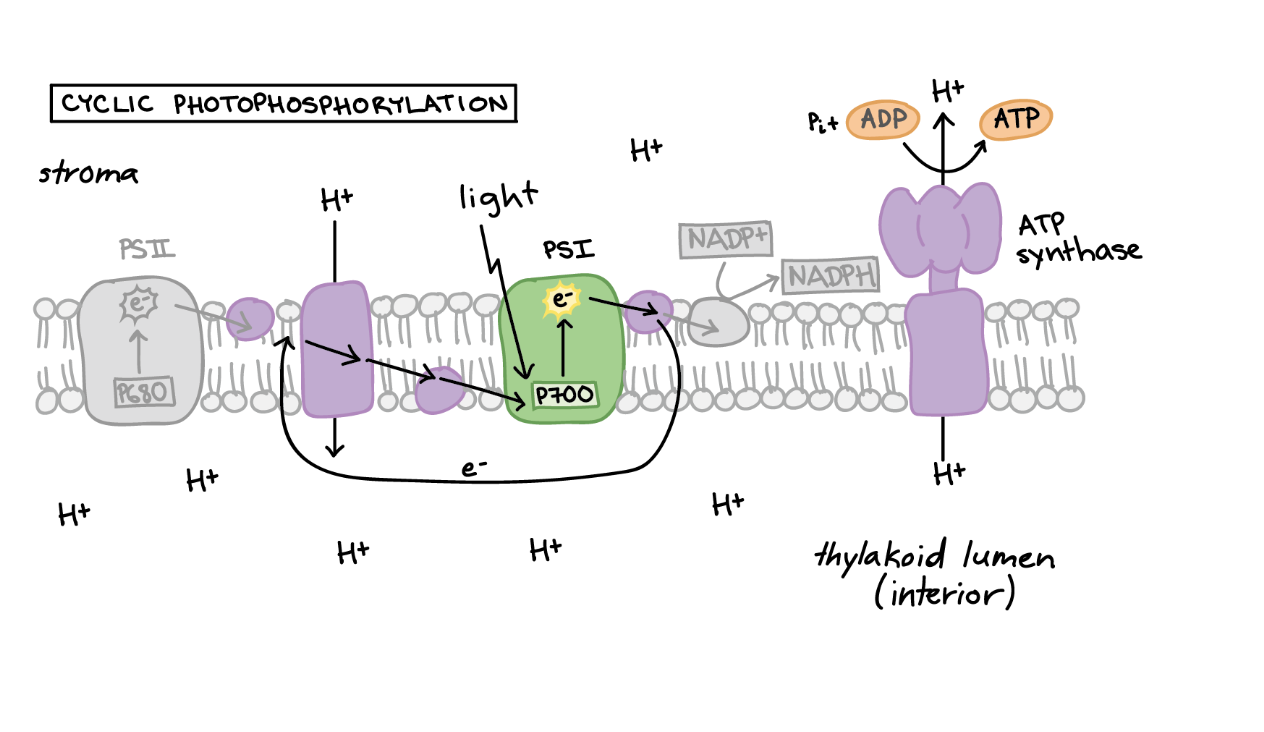
7
New cards
Are the Light Reactions Exo or Endo?
the transfers of electrons from PSII to PSI, and from PSI to NADPH, are only energetically "downhill" (energy-releasing, and thus spontaneous) because electrons in P680 and P700 are boosted to very high energy levels by absorption of energy from light.
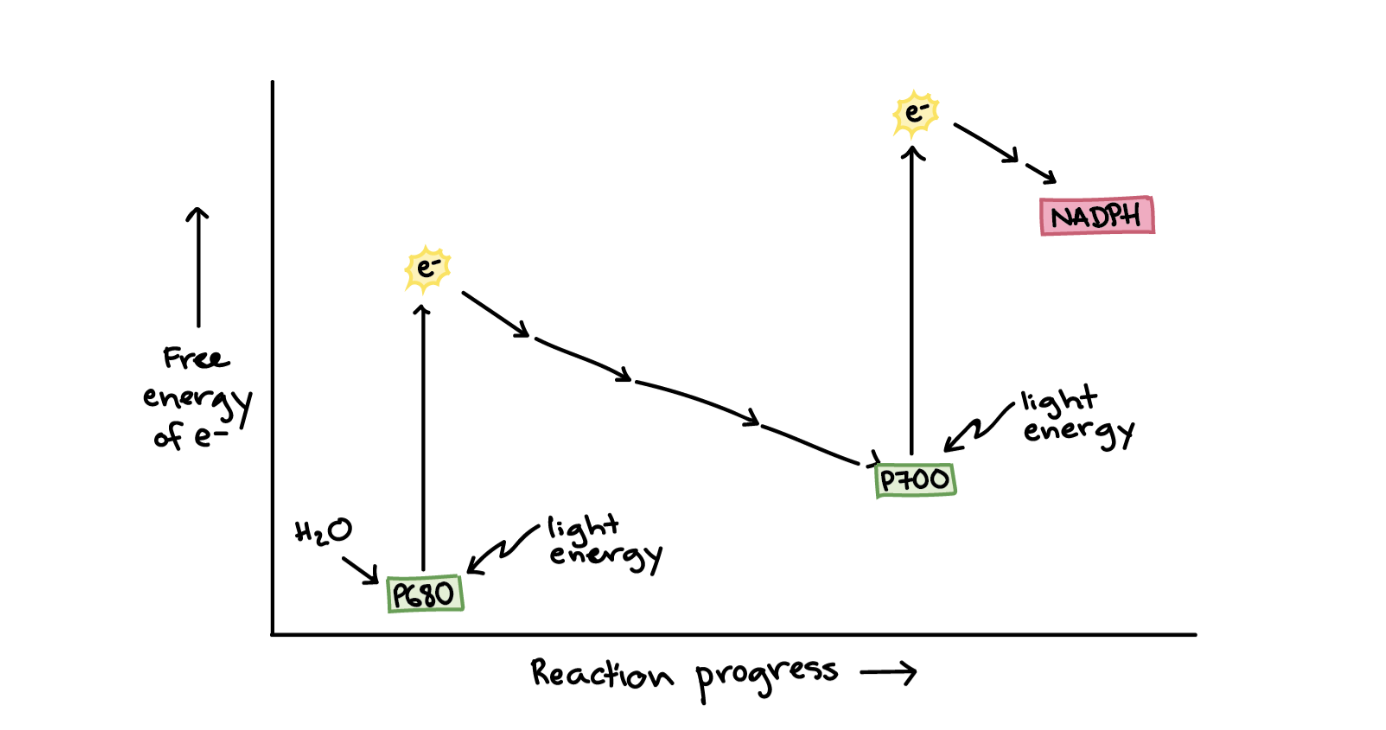
8
New cards
resonance energy transfer
When one of these pigments is excited by light, it transfers energy to a neighboring pigment through direct electromagnetic interactions in a process called resonance energy transfer
9
New cards
what is the special pair, what's its function?
- The reaction center of a photosystem contains a unique pair of chlorophyll a molecules, often called special pair (actual scientific name—that's how special it is!)
- Once energy reaches the special pair, it will no longer be passed on to other pigments through resonance energy transfer
- Instead, the special pair can actually lose an electron when excited, passing it to another molecule in the complex called the primary electron acceptor
- With this transfer, the electron will begin its journey through an electron transport chain.
- Once energy reaches the special pair, it will no longer be passed on to other pigments through resonance energy transfer
- Instead, the special pair can actually lose an electron when excited, passing it to another molecule in the complex called the primary electron acceptor
- With this transfer, the electron will begin its journey through an electron transport chain.
10
New cards
Photosystem I vs. photosystem II
Special pairs:
- The chlorophyll a special pairs of the two photosystems absorb different wavelengths of light. The PSII special pair absorbs best at 680 nm, while the PSI special absorbs best at 700 nm
- Because of this, the special pairs are called P680 and P700, respectively.
Primary acceptor:
- The special pair of each photosystem passes electrons to a different primary acceptor
- The primary electron acceptor of PSII is pheophytin, an organic molecule that resembles chlorophyll, while the primary electron acceptor of PSI is a chlorophyll called A0^7,8
Source of electrons:
- Once an electron is lost, each photosystem is replenished by electrons from a different source
- The PSII reaction center gets electrons from water, while the PSI reaction center is replenished by electrons that flow down an electron transport chain from PSII.
- The chlorophyll a special pairs of the two photosystems absorb different wavelengths of light. The PSII special pair absorbs best at 680 nm, while the PSI special absorbs best at 700 nm
- Because of this, the special pairs are called P680 and P700, respectively.
Primary acceptor:
- The special pair of each photosystem passes electrons to a different primary acceptor
- The primary electron acceptor of PSII is pheophytin, an organic molecule that resembles chlorophyll, while the primary electron acceptor of PSI is a chlorophyll called A0^7,8
Source of electrons:
- Once an electron is lost, each photosystem is replenished by electrons from a different source
- The PSII reaction center gets electrons from water, while the PSI reaction center is replenished by electrons that flow down an electron transport chain from PSII.
